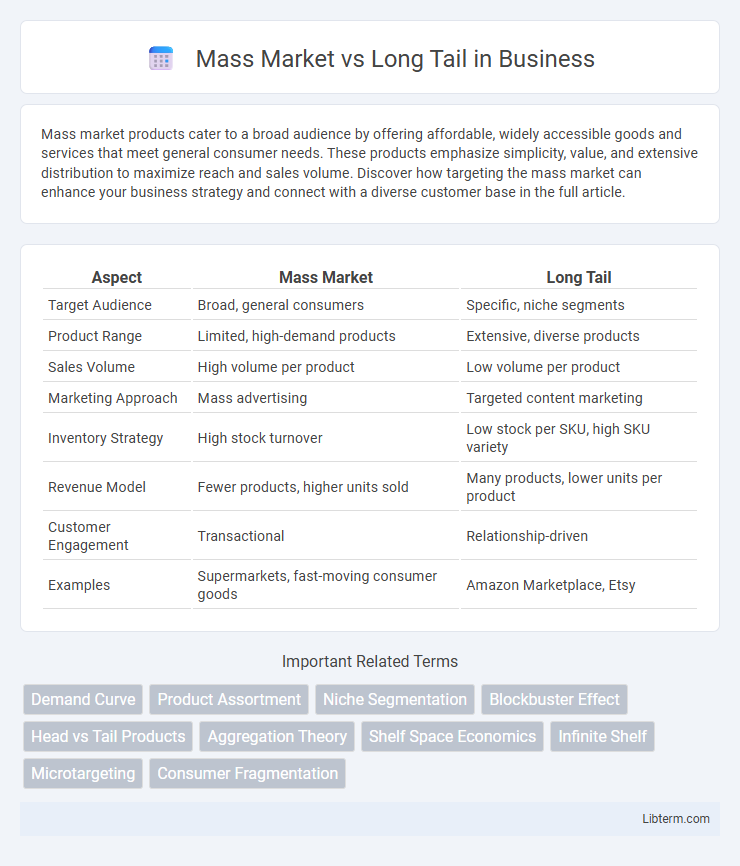Mass market products cater to a broad audience by offering affordable, widely accessible goods and services that meet general consumer needs. These products emphasize simplicity, value, and extensive distribution to maximize reach and sales volume. Discover how targeting the mass market can enhance your business strategy and connect with a diverse customer base in the full article.
Table of Comparison
| Aspect | Mass Market | Long Tail |
|---|---|---|
| Target Audience | Broad, general consumers | Specific, niche segments |
| Product Range | Limited, high-demand products | Extensive, diverse products |
| Sales Volume | High volume per product | Low volume per product |
| Marketing Approach | Mass advertising | Targeted content marketing |
| Inventory Strategy | High stock turnover | Low stock per SKU, high SKU variety |
| Revenue Model | Fewer products, higher units sold | Many products, lower units per product |
| Customer Engagement | Transactional | Relationship-driven |
| Examples | Supermarkets, fast-moving consumer goods | Amazon Marketplace, Etsy |
Understanding the Mass Market: Definition and Characteristics
The mass market targets a broad audience with standardized products designed to appeal to a wide range of consumers, maximizing reach and volume sales. It is characterized by extensive distribution channels, competitive pricing strategies, and high brand visibility to attract the largest possible customer base. Businesses focusing on the mass market prioritize economies of scale, aiming for efficiency in production and marketing to sustain profitability.
What is the Long Tail? Unpacking the Concept
The Long Tail concept refers to a business strategy that targets a large number of niche markets with low demand instead of focusing solely on mass market hits. It leverages the cumulative value of many unique, less popular products or services that collectively generate significant revenue. Digital platforms and online retailers like Amazon and Netflix exemplify the Long Tail by offering diverse catalogs that satisfy specific consumer preferences beyond mainstream options.
Historical Evolution: From Mass Market to Long Tail
The historical evolution from mass market to long tail reflects a shift in consumer demand driven by digital technology and online platforms, enabling niche products to thrive alongside mainstream hits. Traditional mass markets prioritized high-demand, limited selection products to maximize efficiency, while the rise of e-commerce and digital distribution expanded inventory possibilities, connecting diverse consumer interests globally. This transformation reshaped marketing strategies and supply chains by allowing businesses to target smaller, specialized audiences at scale, harnessing data analytics to optimize long tail profitability.
Key Differences Between Mass Market and Long Tail Approaches
Mass Market targets a broad audience with high-demand, popular products, maximizing volume sales through widespread distribution and mainstream appeal. Long Tail focuses on niche markets with specialized products, leveraging diverse inventory and lower individual sales to generate cumulative profit over time. The key difference lies in customer reach and inventory strategy, where Mass Market emphasizes scale and simplicity, while Long Tail prioritizes variety and depth.
Consumer Behavior: Mass Appeal vs. Niche Interests
Mass market strategies target broad consumer segments by emphasizing products with universal appeal, driving high sales volumes through widespread accessibility and standardized offerings. Long tail approaches focus on niche interests by catering to specific consumer preferences, leveraging diversified product selections that satisfy unique demands often overlooked by mainstream markets. Understanding consumer behavior reveals that while mass appeal satisfies immediate, general needs, long tail markets capitalize on specialized tastes, fostering customer loyalty and sustained engagement.
Marketing Strategies: Targeting the Mass Market versus the Long Tail
Mass market marketing strategies emphasize broad appeal by targeting large consumer segments through high-volume, low-cost products and extensive media campaigns leveraging TV, radio, and mainstream digital platforms. Long tail marketing strategies focus on niche audiences by offering specialized products catering to specific interests, using data-driven approaches such as personalized recommendations, SEO, and social media targeting to reach diverse, narrowly defined groups. Businesses employ mass market tactics for fast scalability and brand recognition, while long tail strategies optimize customer engagement and profitability by capitalizing on low-demand, high-variety markets enabled by e-commerce and digital distribution.
Impact of Digital Platforms on Long Tail Growth
Digital platforms have revolutionized the long tail market by enabling niche products to reach global audiences with lower distribution and marketing costs. Algorithms and personalized recommendations increase visibility for less popular items, driving demand beyond traditional mass market offerings. This shift has expanded market diversity and empowered small producers to thrive alongside mainstream brands.
Revenue Models: Bulk Sales vs. Niche Accumulation
Mass market revenue models rely on bulk sales by targeting broad audiences with standardized products, generating high volume and lower margins. Long tail revenue models accumulate niche demand by offering diverse, specialized products that attract smaller, segmented customer bases, resulting in steady, cumulative sales. E-commerce platforms and digital marketplaces often leverage long tail strategies to monetize extensive product catalogs beyond mainstream hits.
Case Studies: Success Stories from Mass Market and Long Tail
Mass market case studies like Apple's iPhone highlight how broad appeal and extensive distribution networks drive massive sales volumes and brand dominance. In contrast, long tail success stories such as Etsy illustrate how niche markets and personalized offerings enable sustained revenue through diverse, low-volume product listings. Both strategies leverage distinct consumer behaviors, with mass market targeting widespread demand and long tail focusing on specialized interests for cumulative profitability.
Future Trends: The Shifting Balance Between Mass and Long Tail
The future landscape of retail will increasingly emphasize the long tail as digital platforms and personalized marketing drive demand for niche products beyond traditional mass-market hits. Advances in AI and data analytics enable businesses to precisely target diverse consumer preferences, making long tail inventory economically viable and fostering greater product variety. Despite this, mass market products will remain foundational for broad appeal and brand recognition, though their dominance will soften as long tail segments capture a larger share of revenue.
Mass Market Infographic

 libterm.com
libterm.com